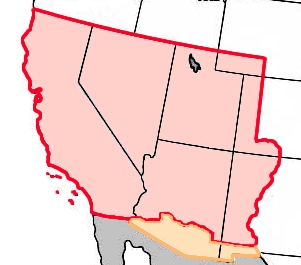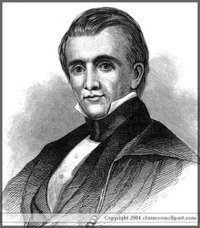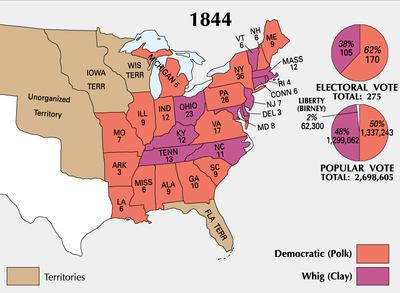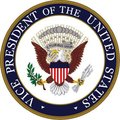James K. Polk
|
|
| ||
| Order: | 11th President | |
| Vice President: | George M. Dallas | |
| Term of office: | March 4, 1845 – March 4, 1849 | |
| Preceded by: | John Tyler | |
| Succeeded by: | Zachary Taylor | |
| Date of birth: | November 2, 1795 | |
| Place of birth: | Mecklenburg County, North Carolina | |
| Date of death: | June 15, 1849 | |
| Place of death: | Nashville, Tennessee | |
| First Lady: | Sarah Childress Polk | |
| Political party: | Democrat | |
James Knox Polk (November 2 1795 – June 15 1849) was the eleventh President of the United States, serving from March 4, 1845 to March 4, 1849. Polk was born in North Carolina, but mostly lived in and represented the state of Tennessee. A Democrat, Polk served as Speaker of the House (1835–1839) and Governor of Tennessee (1839–1841) prior to becoming president. He is (as of 2005) the only former Speaker of the House to become President. He is noted for his expansionist beliefs, for his pledge to serve only one term, and for becoming the first "dark horse" (a candidate who unexpectedly gains the party nomination) to win the presidency.
His term is remembered for the largest expansion of the nation's boundaries since the Louisiana Purchase, through the negotiated establishment of the Oregon Territory and the acquisition of 1.2 million square miles (3,100,000 km²) through the Mexican-American War. He also oversaw the opening of the U.S. Naval Academy and the Washington Monument, and the issuance of the first postage stamps in the United States.
| Contents |
Early life
Polk, the first of ten children, was born on his family's 250 acre (1 km²) farm in Mecklenburg County, North Carolina. His father, Samuel Polk, was a farmer and surveyor of Scots-Irish descent, and related to Scottish Nobility; his mother, Jane Polk (n饠Knox) was a descendant of the Scottish religious reformer John Knox. In 1806, the Polk family moved to Tennessee, settling near Duck River in what is now called Maury County. The family grew prosperous, with Samuel Polk becoming one of the leading gentlemen of the area.
During his childhood, Polk suffered from poor health. In 1812, his father took him to Kentucky, where the then-famous surgeon Dr. Ephraim McDowell conducted an operation to remove his gallstones. James Polk survived the risky surgery, enjoying better health during the rest of his life.
Polk was only educated informally during his childhood. His formal education began at the age of 18, when he joined a religious school near his home. He later attended a school in Murfreesboro, where he met his future wife, Sarah Childress. After less than three years at the school, he left Tennessee to enroll in the University of North Carolina. He graduated in 1818, returning to Nashville to study law under Felix Grundy. Polk was admitted to the bar in 1820, and established his own practice in Columbia.
Political career
Polk was brought up as a Jeffersonian Democrat, for his father and grandfather were strong supporters of Thomas Jefferson. The first public office he held was that of Chief Clerk of the Senate of Tennessee (1821–1823); he resigned the position in order to run his successful campaign for the state legislature. Polk's oratory became popular, earning him the nickname "Napoleon of the Stump." He courted Sarah Childress, and they married on January 1 1824.
Polk became a supporter and close friend of Andrew Jackson, then the leading politician of Tennessee. In 1824, Jackson ran for President, while Polk campaigned for the House of Representatives. Polk succeeded, but Jackson was defeated. Though Jackson had won the popular vote, neither he nor any of the other candidates (John Quincy Adams, Henry Clay, and William H. Crawford) had obtained a majority of the electoral vote, allowing the House of Representatives to select the victor. In his first speech, James Polk expressed his belief that the House's decision to choose Adams was a violation of the will of the people; he even proposed (unsuccessfully) that the Electoral College be abolished.
In Congress, Polk was a firm supporter of Jacksonian principles; he opposed the Second Bank of the United States, favored gold and silver over paper money, and preferred agricultural interests over industrial ones. This behavior earned him the nickname "Young Hickory," an allusion to Andrew Jackson's sobriquet, "Old Hickory." After Jackson defeated Adams in the presidential election of 1828, Polk rose in prominence, becoming the leader of the pro-Administration faction in Congress. As Chairman of the powerful Ways and Means Committee, he lent his support to the President in the conflict over the National Bank.
Soon after Polk became Speaker in 1835, Andrew Jackson left office, to be succeeded by fellow Democrat Martin Van Buren. Van Buren's term was a period of heated political rivalry between the Democrats and the Whigs, with the latter often subjecting Polk to insults, invective, and challenges to duels.
In 1838, the political situation in Tennessee—where, in 1835, Democrats had lost the Governorship for the first time in their party's history—convinced Polk not to seek another term in the House of Representatives. Leaving Congress in 1839, Polk became a candidate in the Tennessee gubernatorial election, defeating fellow Democrat Newton Cannon by about 2,500 votes. Though he revitalized Democrats in Tennessee, his victory could not put a stop to the political decline of the Democratic Party elsewhere in the nation. In the presidential election of 1840, Van Buren was overwhelmingly defeated by a popular Whig, William Henry Harrison. Polk lost his own gubernatorial re-election bid to a Whig, James C. Jones, in 1841. He challenged Jones in 1843, but was defeated once again.
Election of 1844
As the Democratic convention began on May 27 1844, James K. Polk hoped for the vice-presidential nomination. The leading contender for the presidential nomination was former President Van Buren; other candidates included Lewis Cass and James Buchanan. The primary point of political contention involved the Republic of Texas, which, after declaring independence from Mexico in 1836, had asked to join the United States. Van Buren opposed the annexation, but in doing so lost the support of many Democrats, including Andrew Jackson. Van Buren won a simple majority on the convention's first ballot, but did not attain the two-thirds supermajority required for nomination. After six more ballots, when it became clear that Van Buren would not win the required majority, James K. Polk was put forth as a "dark horse" candidate. The eighth ballot was also indecisive, but on the ninth, the convention unanimously nominated Polk, who had by then obtained Van Buren's endorsement. Despite having served as Speaker of the House of Representatives, he was relatively unknown, leading many Whigs to snipe, "Who is James K. Polk?"
When advised of his nomination letter, Polk replied: "It has been well observed that the office of President of the United States should neither be sought nor declined. I have never sought it, nor should I feel at liberty to decline it, if conferred upon me by the voluntary suffrages of my fellow citizens."
The Whig incumbent, John Tyler, had become President when William Henry Harrison died a month after assuming office. Tyler, however, had become estranged from his party, and did not seek a second term; Polk's Whig opponent was, instead, Henry Clay of Kentucky. The question of the annexation of Texas, which was at the forefront during the Democratic Convention, once again dominated the campaign. Polk was a strong proponent of immediate annexation, while Clay seemed more equivocal and vacillating.
Another significant campaign issue, also relating to westward expansion, involved control of the Oregon Country, then under the joint occupation of the United States and the United Kingdom. Polk again vigorously championed the cause of expansion, forcefully suggesting that the United States acquire the entire territory, whose northern boundary was the parallel 54?40'. His campaign slogan became "Fifty-Four Forty or Fight."
Polk's consistent support for westward expansion—in the words of John O'Sullivan, the "Manifest Destiny" of the United States—proved beneficial to his campaign. In the election, Polk won in the South and West, while Clay drew support in the Northeast. Polk won the crucial state of New York, where Clay lost supporters to the third-party candidate James G. Birney. Polk won the popular vote by a margin of over 38,000, and took the Electoral College with 170 votes to Clay's 105. Polk's fellow Democrat, George M. Dallas, became Vice President. Polk was the first, and as of 2005 the only, former Speaker of the House of Representatives to be elected President.
Domestic policy
James_K._Polk_portrait.png
When he took office on March 4 1845, Polk, at 49, became the youngest man to assume the presidency up to his time. Polk set four clearly defined goals for his administration: the re-establishment of the independent treasury, the reduction of tariffs, the settlement of the Oregon boundary dispute, and the acquisition of California from Mexico. Resolved to serve only one term, Polk acted swiftly to fulfill his campaign promises. In just four years, he would oversee the accomplishment of all his objectives.
In 1846, Polk proceeded to carry out his domestic agenda, but at the cost of much discontent in his own party. Congress approved the Walker Tariff (named after Robert J. Walker, the Secretary of the Treasury), which represented a substantial reduction of the high Whig-backed Tariff of 1842. The new law abandoned ad valorem tariffs; instead, rates were made independent of the monetary value of the product. Polk's actions were popular in the South and West; however, they earned him the contempt of many protectionists in the Northeast.
In the same year, Polk also approved an enactment restoring the Independent Treasury system, under which government funds were held in the Treasury, rather than in banks or other financial institutions. The Independent Treasury, created by the Democrats in 1840, had been abolished by the Whigs in 1841. After Polk re-established it, the Independent Treasury continued to remain in existence until 1920. The Independent Treasury Act, however, incurred the displeasure of many pro-bank Democrats.
Foreign policy
Before Polk entered office, his predecessor, John Tyler, interpreted his victory as a mandate for the annexation of Texas. President Tyler urged Congress to pass a joint resolution admitting Texas to the Union; Congress complied on February 28 1845. Tyler had acted quickly because he feared British designs on Texas. The Republic of Texas did not accept the offer until later in the year, after Polk entered office; it officially became a part of the Union only on December 29 1845. This move, however, angered Mexico, which had offered Texas its independence on the condition that it should not attach itself to any other nation.

Polk also sought to address the Oregon boundary dispute. Since 1818, Oregon had been under the joint occupation and control of Britain and the United States; Polk, however, demanded sovereignty over the whole territory. Though he had campaigned on the slogan "Fifty-Four Forty or Fight," Polk was not prepared to wage war with the British, especially when the acceptance of Texas into the Union had already made Mexico a hostile power. Polk preferred to accept a compromise offered by the British Foreign Secretary, Lord Aberdeen, and ratified the Oregon Treaty. The treaty divided the Oregon Country between the two countries along the 49th parallel. Although there were many who still clamored for the whole of Oregon, the treaty was approved by the Senate. The portion of Oregon acquired by the United States would later form the states of Washington, Oregon, and Idaho, and parts of the states of Montana and Wyoming.
The President turned his attention to the acquisition of California, and in this case, he was prepared to go to war if necessary (see the Mexican-American War). In 1845, Polk had sent a diplomat, John Slidell, to Mexico to negotiate the purchase of California and New Mexico. Although Slidell was prepared to offer up to $40 million, the Mexicans, angered by the annexation of Texas, refused to bargain. In January 1846, Polk ordered General Zachary Taylor to lead his troops into the area between the Nueces River and the Rio Grande—territory that was claimed by both Texas and Mexico. As negotiations continued to prove fruitless, Polk prepared to ask Congress for a declaration of war. Serendipitously, mere days before Polk intended to make his request to Congress, he received word that Mexican forces had crossed the Rio Grande area and killed eleven American troops. Polk amended his planned speech and changed his casus belli, stating that Mexico had "invaded our territory and shed American blood upon the American soil." However, he ignored the point that the territory in question was disputed, and did not unequivocally belong to the United States. A Whig congressman, future President Abraham Lincoln, introduced the "Spot Resolutions," which demanded that Polk point out the precise "spot" where American blood had been spilt. Such technical points, however, were largely ignored by the public, especially in the South and the West. Congress easily approved the declaration of war, with many Whigs fearing that they would have lost the support of their constituents had they voted for peace.

By the summer of 1846, New Mexico had been conquered by American forces under General Stephen W. Kearny. Meanwhile, American settlers in California, led by John C. Fr魯nt, rebelled against Mexican rule, and established the independent California Republic. General Zachary Taylor, at the same time, met with success on the Rio Grande. The United States also negotiated a secret arrangement with Antonio L de Santa Anna, the Mexican general and dictator who had been overthrown in 1844. Santa Anna agreed that, if given safe passage into Mexico, he would attempt to persuade those in power to sell California and New Mexico to the United States. Once he reached Mexico, however, he reneged on his agreement, declared himself President, and tried to fight the American invaders back. Santa Anna's efforts, however, were in vain, as Generals Zachary Taylor and Winfield Scott destroyed all resistance.
Polk sent a diplomat named Nicholas Trist to negotiate with the Mexicans. Delays in the process prompted the President to order Trist to return to the United States, but the diplomat ignored the instructions, staying in Mexico to continue bargaining. Trist successfully negotiated the Treaty of Guadalupe Hidalgo in 1848, which Polk agreed to ratify, ignoring calls from Democrats who demanded the annexation of the whole of Mexico. The treaty added 1.2 million square miles (3,100,000 km²) of territory to the United States; Mexico's size was halved, whilst that of the United States increased by a quarter. California, New Mexico, Arizona, Nevada, Utah, and parts of Colorado and Wyoming were all carved from the Mexican Cession. The treaty also recognised the annexation of Texas, and acknowledged American control over the disputed territory between the Nueces and the Rio Grande. Mexico, in turn, received the sum of $15 million. The war involved less than 20,000 American casualties, but over 50,000 Mexican ones; it had cost the United States nearly $100 million.
Post-presidency
James_K_Polk_Tomb.jpg
Polk's considerable political accomplishments took their toll on his health. He became more tired and lost weight, and deep lines and dark circles etched his face. Full of enthusiasm and vigor when he entered office, Polk left the White House on March 4, 1849, exhausted by his years of public service. He was succeeded in office by the hero of the Mexican-American War, the Whig General Zachary Taylor. Although Polk expected a peaceful retirement, he contracted cholera in New Orleans, Louisiana on a good will tour of the South.
Polk died only 103 days after leaving the White House, at his new home, Polk Place, in Nashville, Tennessee, at 3:15 on the afternoon of Friday, June 15, 1849. Polk's devotion to his wife is illustrated by his last words: "I love you, Sarah. For all eternity, I love you." She lived at Polk Place for over forty years after his passing, a retirement longer than that of any other First Lady of the United States.
He was the youngest President to die, until James A. Garfield and John F. Kennedy, both of whom were assassinated during their presidencies. His post-presidential life was, furthermore, the shortest in the history of the United States.
Both James and Sarah are buried in a tomb on the grounds of the Tennessee State Capitol Building, in Nashville.
Legacy
Many historians rank Polk as a near-great President, lauding the extent of his achievements in a single term: Polk had attained all four of his primary policy objectives. One could argue, however, that Polk failed to acquire the whole of the Oregon Country, as he promised during his campaign. Moreover, his decision to send Zachary Taylor into disputed territory, and his subsequent justification of the Mexican-American War, have been condemned by some.
Polk's actions in relation to Mexico involved significant consequences for the United States. In 1846, Congressman David Wilmot of Pennsylvania introduced a proposal known as the Wilmot Proviso, which would have outlawed slavery in any U.S. territory acquired in the course of the war. Though the House passed the Proviso on numerous occasions, it was blocked by southern Senators. The Compromise of 1850 temporarily settled the dispute; California was admitted to the Union as a "free state," while the other territories carved out of the Mexican Cession were allowed to permit or prohibit slavery as they saw fit. The Compromise of 1850, however, failed to satisfy extremists on both sides. Disputes over slavery in the West, together with other inflammatory events of the 1850s, contributed to the American Civil War, which began in 1861.
President Polk is also notable for his support for the concept of Manifest Destiny—the idea that it was the United States' divine mission to expand westward—and for his affirmation of the Monroe Doctrine—the doctrine, first propounded by President James Monroe in 1823, that the Americas should be free from European colonization or other interference.
Polk is the subject of a song, James K. Polk, by American pop group They Might Be Giants. It appeared on their 1996 album "Factory Showroom" and was a surprisingly complete account of his presidential nomination and subsequent career, ending with a lament of his continued obscurity.
A number of United States counties are named after Polk. These include Polk County, Oregon, originally established in 1845. Polk County in Northwest Georgia, was founded in 1851. Polk County, Florida was founded ten years later in 1861. Polk County, Nebraska was the fourth county founded West of the Missouri River in 1870. Polk County, Missouri, founded in 1835, was originally named in honor of a Revolutionary War hero Ezekiel Polk. When the Missouri legislature acted to create the county, they chose to honor the then current Speaker of the House, James K. Polk.
Cabinet
| OFFICE | NAME | TERM |
| President | James K. Polk | 1845–1849 |
| Vice President | George M. Dallas | 1845–1849 |
| Secretary of State | James Buchanan | 1845–1849 |
| Secretary of the Treasury | Thomas Ewing | 1845–1849 |
| Secretary of War | William L. Marcy | 1845–1849 |
| Attorney General | John Y. Mason | 1845–1846 |
| Nathan Clifford | 1846–1848 | |
| Isaac Toucey | 1848–1849 | |
| Postmaster General | Cave Johnson | 1845–1849 |
| Secretary of the Navy | George Bancroft | 1845–1846 |
| John Y. Mason | 1846–1849 | |
U.S. Supreme Court appointments
Polk appointed the following Justices to the U.S. Supreme Court:
- Levi Woodbury (1845)
- Robert Cooper Grier (1846)
States admitted to the Union
- Texas – December 29, 1845
- Iowa – December 28, 1846
- Wisconsin – May 29, 1848
They Might Be Giants
American pop/rock band, They Might Be Giants recorded a song about Polk on their Factory Showroom album.
About the song, the band said:-
This song was written with childhood friend Mr. Matthew Hill. Originally featured as a b-side, its legacy has grown with hardcore TMBG fans, and now has been resurrected in full hi-fi for Factory Showroom. The lyrics are as factual as we could make them with the reference books handy. James Knox Polk, the 11th President of the U.S., was a dark horse candidate who unexpectedly won the Democratic nomination and the election based on his popularity in the South with his stated goal of annexing Texas, the Southwest, and the Oregon Territories. Once in office he fanned the flames of dispute between the U.S. and Mexico to achieve part of this aim. (The Mexican War is still commemorated in the expression "Remember the Alamo!") Personally, we find his expansionist policies ruthless and unscrupulous, but the existence of the Western U.S. is largely due to him. The spooky sound halfway into this recording is a "singing saw," an actual metal saw stroked with a bow by Mr. Julian Koster.
See also
References
- Bergeron, Paul H. The Presidency of James K. Polk. 1986. ISBN 0700603190.
- Cutler, Wayne, et. al. Correspondence of James K. Polk: July–December 1845. 2004. ISBN 1572333049.
- Dusinberre, William. Slavemaster President: The Double Career of James Polk. 2003. ISBN 0195157354.
- Haynes, Sam W. James K. Polk and the Expansionist Impulse. 2001. ISBN 0321087984.
- Leonard, Thomas M. James K. Polk: A Clear and Unquestionable Destiny. 2000. ISBN 0842026479.
- McCormac, Eugene Irving.James K. Polk: A Political Biography to the End of a Career 1845-1849. 1995. ISBN 094570710X.
- Schlesinger, Arthur M., and John Seigenthaler. James K. Polk: 1845–1849. 2003. ISBN 0805069429.
History Clipart and Pictures
- Pictures of the US Presidents (http://classroomclipart.com/cgi-bin/kids/imageFolio.cgi?direct=History/United_States/Presidents)
- Clipart of American Presidents (http://classroomclipart.com/cgi-bin/kids/imageFolio.cgi?direct=Clipart/American_Presidents)
- Historical Pictures of the United States (http://classroomclipart.com/cgi-bin/kids/imageFolio.cgi?direct=History/United_States)
- Pictures of the American Revolution (http://classroomclipart.com/cgi-bin/kids/imageFolio.cgi?direct=History/United_States/American_Revolution)
- Civil Rights Pictures (http://classroomclipart.com/cgi-bin/kids/imageFolio.cgi?direct=History/United_States/Civil_Rights)
- Civil War Images (http://classroomclipart.com/cgi-bin/kids/imageFolio.cgi?direct=History/United_States/Civil_War)
- Pictures of Colonial America (http://classroomclipart.com/cgi-bin/kids/imageFolio.cgi?direct=History/United_States/Colonial_America)
- Historical US Illustrations (http://classroomclipart.com/cgi-bin/kids/imageFolio.cgi?direct=History/United_States/Illustrations)
- World War II Pictures (http://classroomclipart.com/cgi-bin/kids/imageFolio.cgi?direct=History/United_States/World_War_II)
- Pictures of Historical People (http://classroomclipart.com/cgi-bin/kids/imageFolio.cgi?direct=History/United_States/People)
External links
- Inaugural Address of James K. Polk. (http://www.yale.edu/lawweb/avalon/presiden/inaug/polk.htm)
- Biography of James K. Polk. The White House (Official Site). (http://www.whitehouse.gov/history/presidents/jp11.html)
- First State of the Union Address (1845). (http://www.usa-presidents.info/union/polk-1.html)
- Second State of the Union Address (1846). (http://www.usa-presidents.info/union/polk-2.html)
- Third State of the Union Address (1847). (http://www.usa-presidents.info/union/polk-3.html)
- Fourth State of the Union Address (1848). (http://www.usa-presidents.info/union/polk-4.html)




